9 NASA-Approved Plants That Purify Your Air While You Sleep
NASA has identified several powerful air-purifying plants that work while you sleep. I've found that snake plants, peace lilies, and spider plants are top performers, removing harmful toxins like formaldehyde and benzene from your bedroom air. The bamboo palm and dracaena also excel at filtering indoor pollutants, while golden pothos, aloe vera, Boston ferns, and weeping figs round out this elite group. Each plant brings unique benefits – some thrive in low light, others add humidity, and a few are pet-friendly. Let's explore how these natural air filters can transform your sleeping space into a healthier sanctuary.
Contents
- 1 Snake Plant
- 2 Peace Lily
- 3 Spider Plant
- 4 Bamboo Palm
- 5 Dracaena
- 6 Golden Pothos
- 7 Aloe Vera
- 8 Boston Fern
- 9 Weeping Fig
- 10 Frequently Asked Questions
- 10.1 How Long Do These Plants Take to Noticeably Improve Indoor Air Quality?
- 10.2 Are Nasa-Approved Air-Purifying Plants Safe for Households With Cats and Dogs?
- 10.3 Do These Plants Work Effectively in Rooms With Artificial Lighting?
- 10.4 What's the Minimum Number of Plants Needed per Square Foot for Effectiveness?
- 10.5 Can These Plants Remove Cigarette Smoke and Cooking Odors From Indoor Air?
Snake Plant
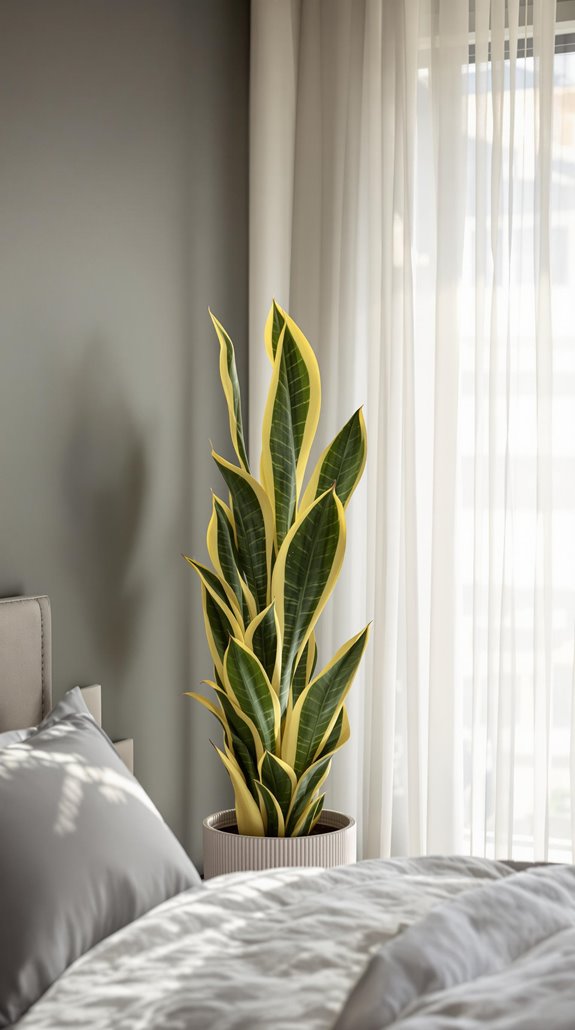
Since NASA's groundbreaking Clean Air Study in the 1980s, the Snake Plant (Sansevieria trifasciata) has earned its reputation as one of the most effective air-purifying houseplants. I recommend placing this hardy succulent in your bedroom, as it converts CO2 into oxygen at night while removing toxins like formaldehyde, benzene, and trichloroethylene from your air.
You'll love how easy it is to care for a Snake Plant. I've found it thrives in both bright and low-light conditions, and it's nearly impossible to kill. You only need to water it every 2-3 weeks, making it perfect if you're busy or often travel. I particularly appreciate its tall, striking leaves and compact growth pattern, which means it won't take up much space while helping you breathe cleaner air.
Peace Lily
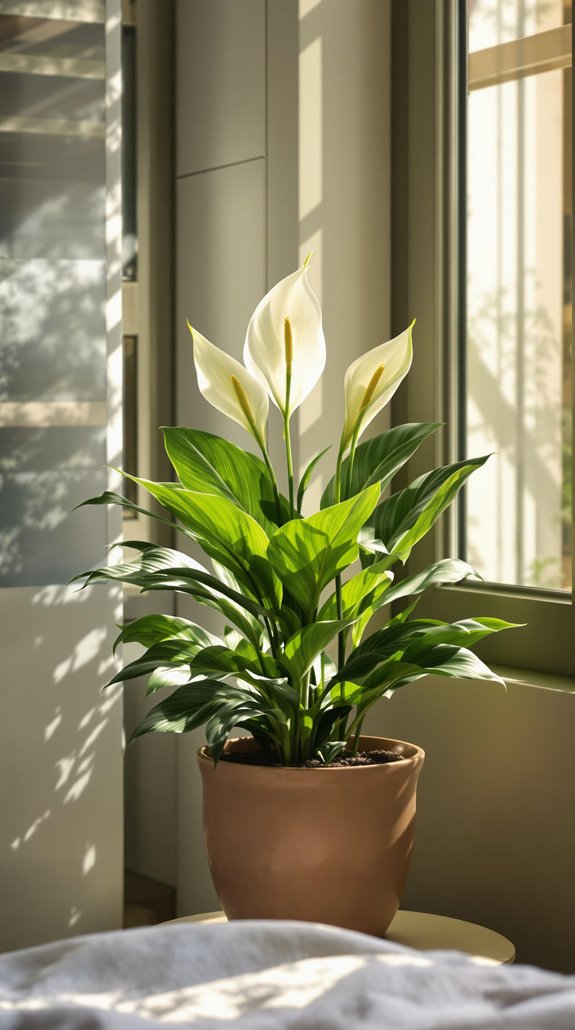
The Peace Lily (Spathiphyllum) stands among NASA's top air-purifying plants, and I've found it exceptionally effective at removing common indoor pollutants like ammonia, benzene, and formaldehyde. This elegant plant thrives in low to medium light conditions, making it perfect for bedrooms and offices where natural light might be limited.
I recommend watering your Peace Lily when the top inch of soil feels dry. You'll notice it dramatically droops when thirsty, but it quickly perks up after watering. While it's toxic to pets and humans if ingested, I keep mine on elevated surfaces to prevent any accidents.
What I love most about this plant is its ability to increase room humidity by up to 5%. Plus, its white flowers add a touch of sophistication to any space while it quietly cleanses your air.
Spider Plant
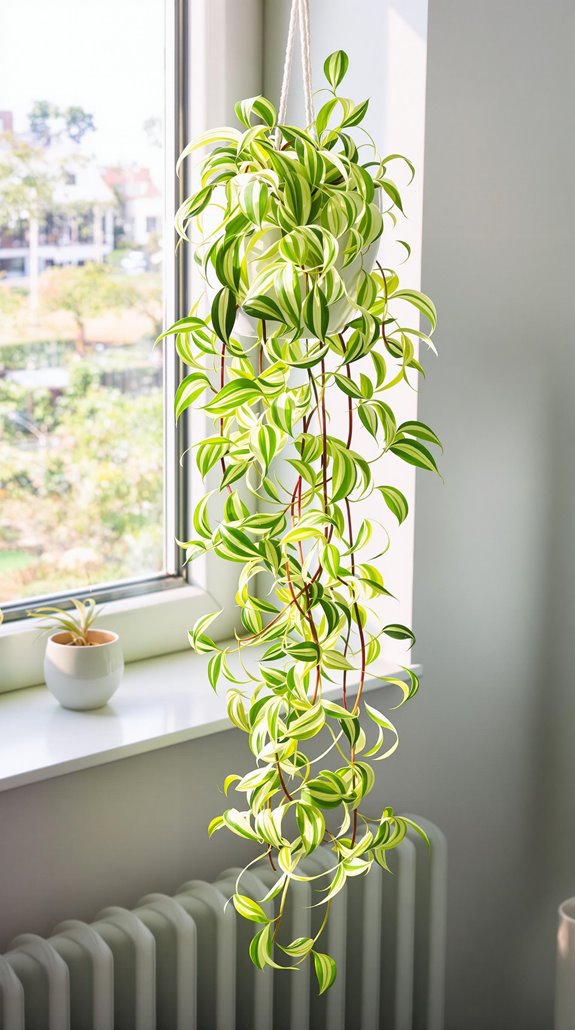
Swinging gracefully from hanging baskets, Spider Plants (Chlorophytum comosum) rank among NASA's most efficient air purifiers. I love how these hardy plants remove up to 95% of toxic substances like formaldehyde, carbon monoxide, and xylene from indoor air within just two days.
You'll find Spider Plants incredibly easy to maintain – they thrive in bright, indirect light and can tolerate occasional neglect. I recommend keeping the soil slightly moist but not waterlogged. When you notice baby plantlets forming on long stems, you can either leave them for a dramatic cascading effect or propagate them to create new plants.
What I appreciate most is their pet-friendly nature, making them safe for homes with cats and dogs. They're also excellent choices for offices, as they adapt well to artificial lighting and varying temperatures.
Bamboo Palm
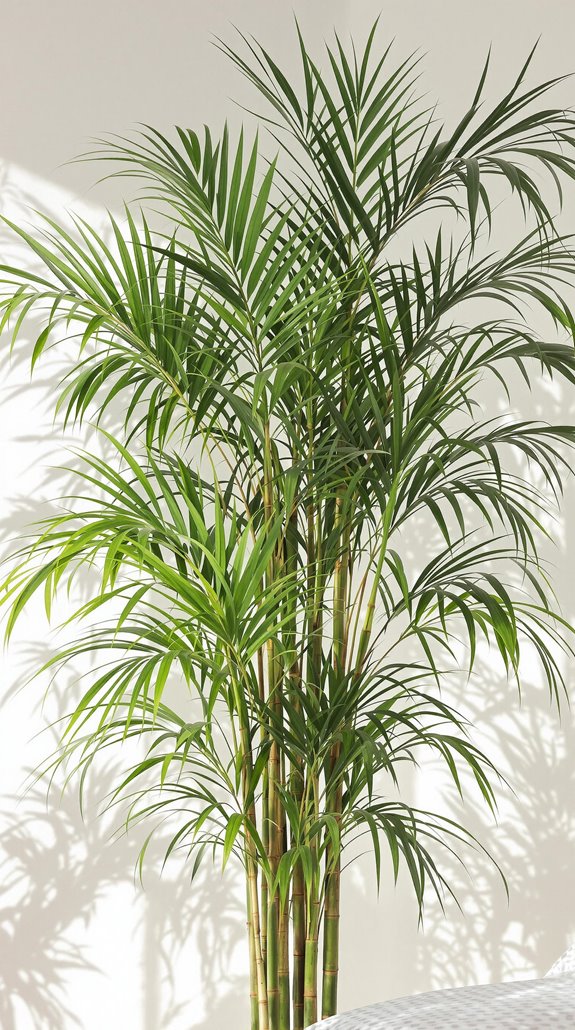
Among NASA's top-rated air purifiers, Bamboo Palm (Chamaedorea seifrizii) stands out for its remarkable ability to filter benzene, trichloroethylene, and formaldehyde from indoor spaces. I love how this elegant palm thrives in low-light conditions, making it perfect for bedrooms and offices where natural sunlight is limited.
I've found that Bamboo Palms grow best in well-draining soil and prefer temperatures between 65-80°F. While they can reach heights of 6-12 feet indoors, I recommend pruning them to maintain a manageable size. You'll want to keep the soil consistently moist but not waterlogged, and mist the fronds occasionally to maintain humidity. Watch out for spider mites, which can be prevented by regular cleaning of the leaves with a damp cloth.
Dracaena
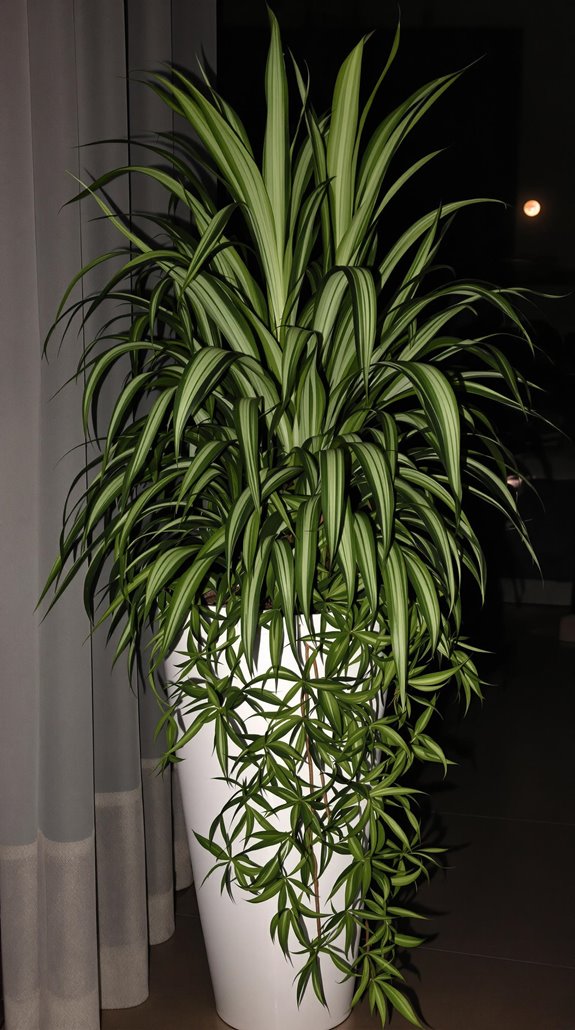
Like its tropical cousin the Bamboo Palm, Dracaena has earned its spot on NASA's list of top air-purifying plants. I've found this hardy plant to be incredibly effective at removing formaldehyde, benzene, and trichloroethylene from indoor air. You'll often find these harmful chemicals lurking in household items like synthetic fabrics, plastics, and cleaning products.
I particularly love that Dracaena comes in over 40 different varieties, with the Janet Craig, Warneckii, and Marginata being the most powerful air purifiers. You can easily grow these low-maintenance plants in medium to low light, and they'll thrive with just moderate watering. I should warn you that Dracaena is toxic to pets, so if you have cats or dogs, you'll want to place it out of their reach or consider an alternative plant.
Golden Pothos
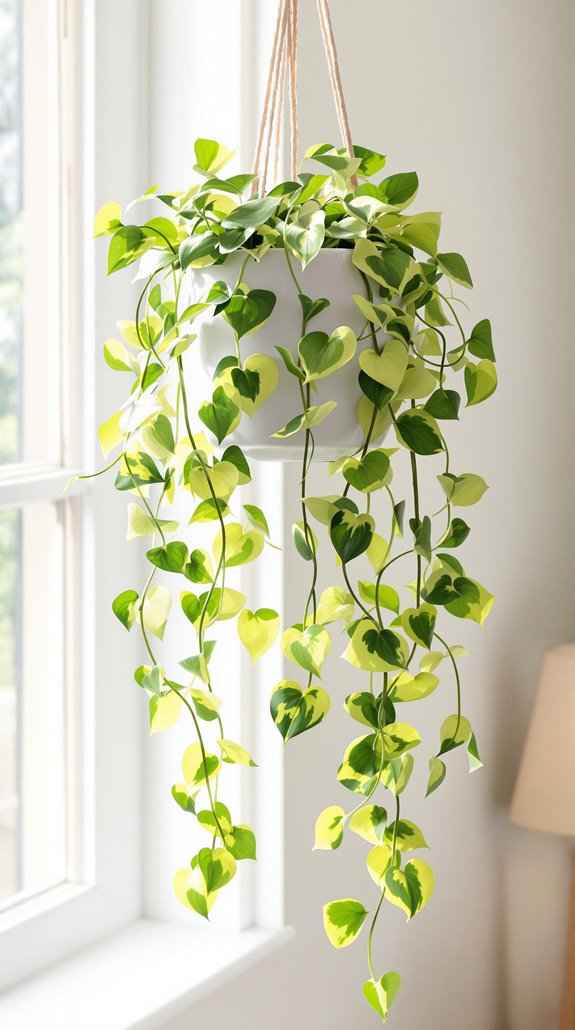
Thanks to its exceptional air-purifying abilities, Golden Pothos ranks high on NASA's list of effective indoor plants. I've found this hardy vine to be particularly effective at removing indoor pollutants like formaldehyde, xylene, and benzene from the air, making it an excellent choice for bedrooms and living spaces.
I love that Golden Pothos is nearly impossible to kill, thriving in various light conditions and requiring minimal maintenance. You'll recognize it by its heart-shaped leaves with yellow-gold variegation. I recommend placing it in hanging baskets or letting it climb walls, as its trailing vines can grow up to 40 feet long. Just keep it away from pets and children, as its leaves are toxic if ingested. A word of caution: don't overwater it – I let the soil dry between waterings to prevent root rot.
Aloe Vera
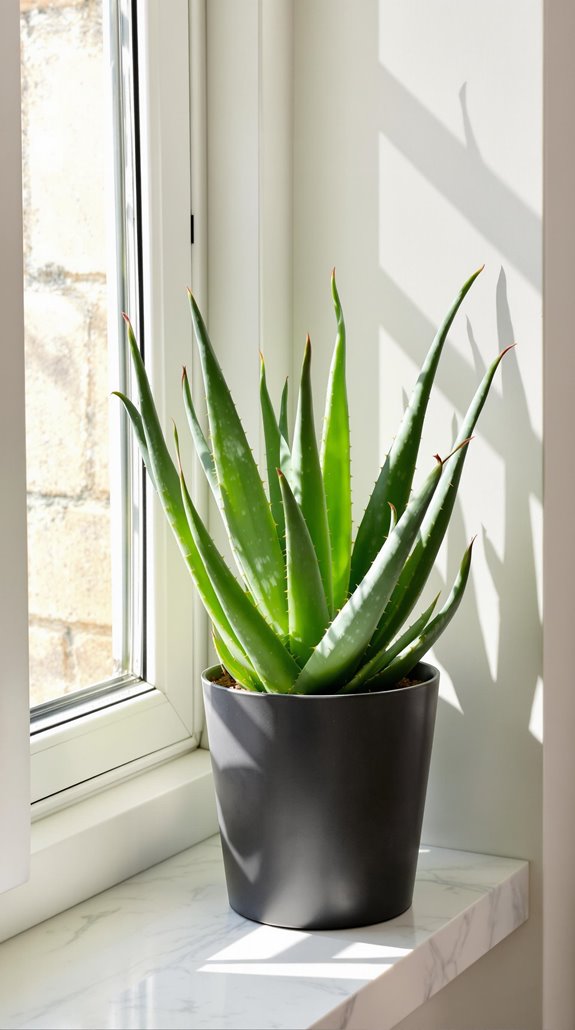
While many houseplants improve air quality, Aloe Vera stands out on NASA's list for its exceptional ability to remove formaldehyde and benzene from indoor spaces. I find this succulent particularly valuable because it's both an air purifier and a natural first-aid kit. You can break off a leaf and use its gel to soothe burns, cuts, and skin irritations.
I recommend placing Aloe Vera in your bedroom since it releases oxygen at night while absorbing carbon dioxide. It's also extremely low-maintenance – I only water mine when the soil is completely dry. The plant thrives in bright, indirect sunlight and can alert you to air pollution through brown spots on its leaves. If you're new to plant care, you'll appreciate that Aloe Vera is nearly impossible to kill and doesn't need frequent repotting.
Boston Fern
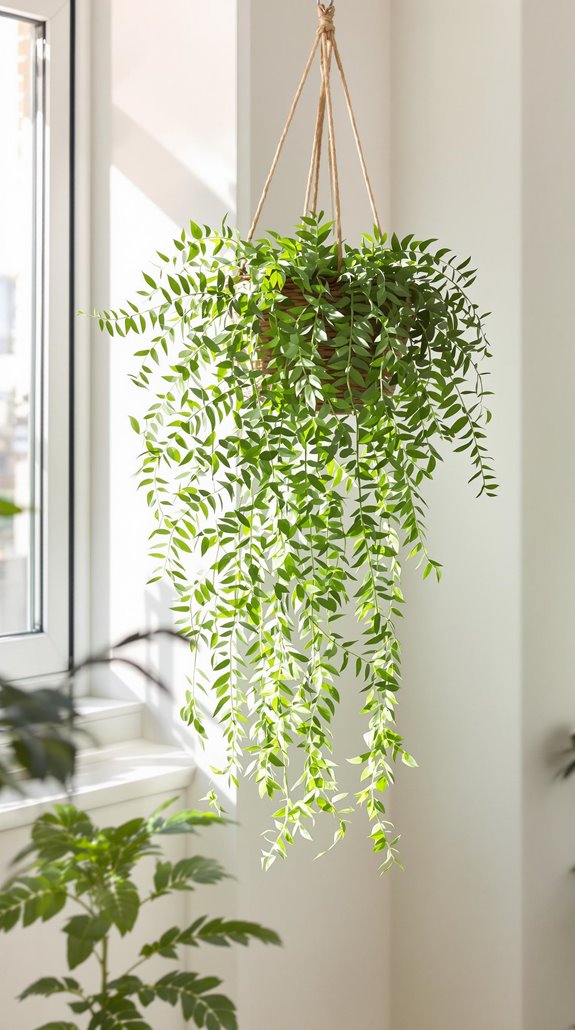
Moving from desert-dwelling Aloe Vera to humidity-loving plants, the Boston Fern ranks among NASA's top air-purifying powerhouses. I've found these lush, feathery fronds excel at removing formaldehyde, xylene, and other indoor pollutants from your air while you sleep.
I recommend placing your Boston Fern in a bathroom or kitchen, where it'll thrive in the natural humidity. You'll need to keep the soil consistently moist and mist the leaves regularly, as these ferns don't tolerate dry conditions. I've noticed they perform best in bright, indirect light, though they'll adapt to lower light situations.
While they require more attention than some houseplants, their air-cleaning abilities make them worth the effort. One large Boston Fern can filter significant amounts of indoor air pollutants within 24 hours.
Weeping Fig
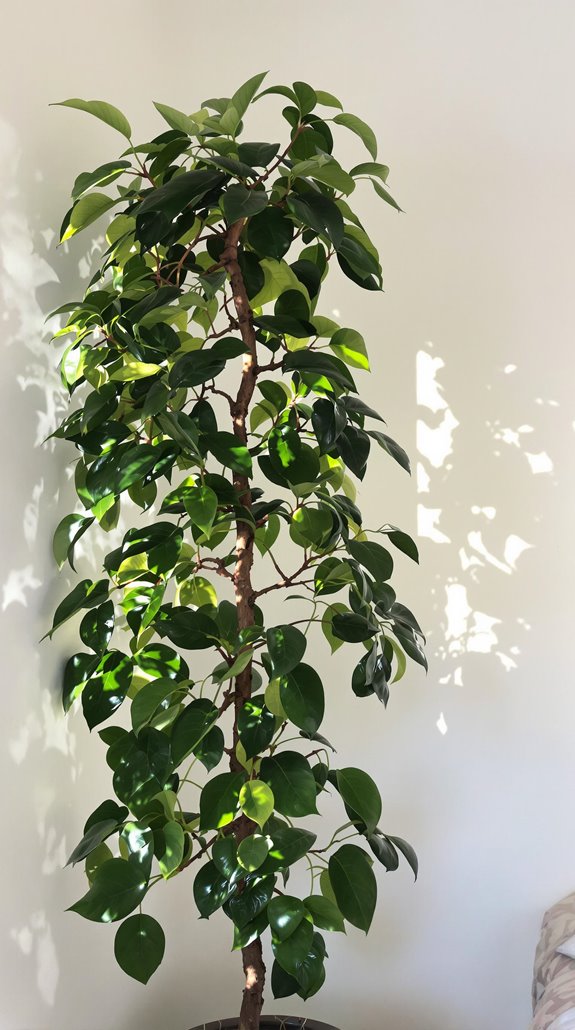
Known around the world for its graceful drooping branches, the Weeping Fig (Ficus benjamina) stands out as one of NASA's most effective air-purifying plants. I've found this elegant tree-like houseplant particularly effective at removing common indoor pollutants like formaldehyde, xylene, and toluene from the air.
While I recommend placing a Weeping Fig in your home, I must warn you that it's sensitive to changes in environment. It'll often drop leaves when moved or exposed to drafts. You'll want to keep it in bright, indirect light and maintain consistent watering. Don't worry if you can't accommodate a full-sized tree – you can easily maintain it at a smaller size through pruning. Just remember that the plant's sap can be irritating to skin and toxic to pets, so handle with care.
Frequently Asked Questions
How Long Do These Plants Take to Noticeably Improve Indoor Air Quality?
I'll help you understand the timeline for air-purifying plants. You'll notice improvements in indoor air quality within 24 hours, but ideal results typically take 10-14 days of continuous exposure. I recommend having at least one plant per 100 square feet of space. Keep in mind that factors like plant size, species, and room ventilation affect purification speed. For best results, I suggest maintaining healthy plants in well-lit areas.
Are Nasa-Approved Air-Purifying Plants Safe for Households With Cats and Dogs?
Let me cut to the chase: not all air-purifying plants are safe for your furry friends. I always recommend checking the ASPCA's toxic plant database before bringing any greenery home. Popular options like peace lilies and snake plants can be harmful if ingested by cats or dogs. Instead, I'd suggest pet-safe alternatives like Boston ferns, spider plants, or areca palms. They'll keep your air clean while keeping your pets safe.
Do These Plants Work Effectively in Rooms With Artificial Lighting?
I'll tell you straight up – most air-purifying plants can survive under artificial lighting, but they won't be as effective at cleaning your air compared to when they receive natural light. To get the best results, I recommend placing these plants where they'll get at least some indirect sunlight. If you're limited to artificial light, choose hardy varieties like snake plants or pothos, and use full-spectrum grow lights.
What's the Minimum Number of Plants Needed per Square Foot for Effectiveness?
Like spacing soldiers strategically on a battlefield, I've learned that placing air-purifying plants requires careful calculation. I recommend following NASA's guideline of one plant per 100 square feet of indoor space. However, I've found that factors like air quality, room size, and plant type can affect this ratio. If you're dealing with higher pollution levels, I'd suggest doubling that number for better results.
Can These Plants Remove Cigarette Smoke and Cooking Odors From Indoor Air?
I want to clarify something about using plants for smoke and odor removal. While plants can help filter some airborne chemicals, they're not highly effective at removing cigarette smoke or cooking odors on their own. You'll need proper ventilation and air purifiers for those specific concerns. Plants mainly help with certain VOCs (volatile organic compounds), but they work too slowly to tackle immediate smoke or strong food smells.
